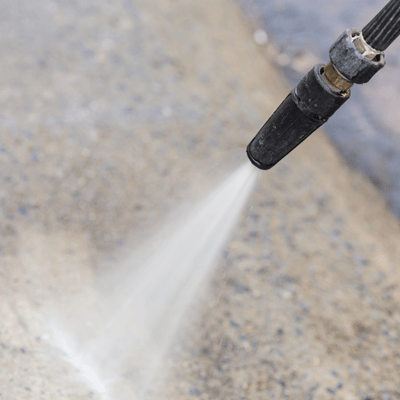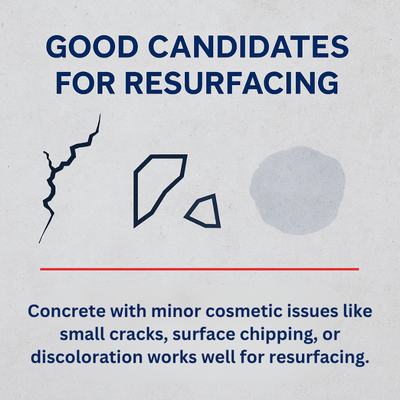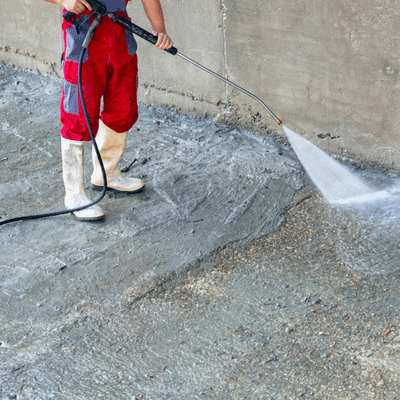Concrete is tough and long-lasting, but even the strongest concrete surfaces show wear over time. Concrete resurfacing offers a cost-effective solution to give old concrete new life without replacing the entire slab. This guide explains what is resurfacing concrete, how it works, and why it is perfect for homeowners and property managers looking to restore their concrete surfaces quickly and affordably.
Instead of demolishing and removing your existing concrete, professionals apply a thin concrete overlay that bonds tightly to the original slab. This overlay fills small cracks, levels minor dips, and creates a smooth finish that can be colored or textured to match any design style. Because the process uses fewer materials and less labor, it keeps project costs low and turnaround times short. With proper preparation and quality materials, resurfacing delivers a refreshed, strong surface that withstands weather, heavy loads, and daily use for years to come.
Concrete resurfacing is a restoration method that adds a thin layer of specialized material over your existing concrete surface. Instead of tearing out and pouring new concrete, resurfacing applies a cement based overlay that bonds to the existing surface. This new layer covers surface imperfections, minor cracks, stains, and worn areas while preserving the underlying concrete structure.
What's in a concrete resurfacer? Most resurfacing material contains Portland cement, fine sand, polymers, and other additives. These ingredients create a strong bond and resist shrinkage. When mixed with water, this compound spreads easily over prepared old concrete. It adheres to a properly prepared surface and forms a durable surface that looks like fresh concrete.
When should you resurface? Concrete resurfacing works best on concrete that's structurally sound. Small pits, surface flaking, and minor cracks can be covered effectively by an overlay. However, deep cracks, major settling, or severe damage indicate structural problems that resurfacing can't fix. If your concrete has minor cosmetic issues but remains stable, resurfacing is likely the perfect resurfacing solution.
Concrete resurfacing offers many advantages that make it attractive for property owners:

Resurfacing is a cost-effective option to full concrete replacement. By revitalizing existing concrete with a thin concrete overlay, contractors use fewer materials and less labor, which lowers costs. Basic concrete resurfacing typically runs only a few dollars per square foot compared with the higher price of pouring new slabs. When application techniques focus on proper adhesion and limit surfaces exposed to weather during cure, the renewed slab can last years. Concrete resurfacing also reduces long-term maintenance requirements, making it a smart strategy for extending concrete life while saving money.
A concrete resurfacing project can transform an existing concrete surface in just days. Once the existing surface is properly prepared and surface imperfections are patched, most jobs finish in one to two days, whereas pouring new concrete can stretch past a week. Many modern blends used in professional or DIY concrete resurfacing set quickly; the area can take walking traffic within six to eight hours and vehicle loads in 24 to 48 hours. The rapid turnaround keeps disruption minimal and extends slab life.
A concrete overlay isn't just plain gray. You can choose from many decorative finishes and concrete resurfacing selections to match your style. The resurfacing material can be colored, stained, or stamped to look like natural stone, brick, or tile. Epoxy coatings with added pigments fit modern pool decks or patios. Decorative options also allow crack repair on the existing surface and significantly enhance the appearance of walkways, turning the concrete overlay into custom art.
A properly installed concrete overlay creates a strong surface that tolerates regular foot traffic and vehicle traffic. Modern concrete resurfacing mixes incorporate polymers and fibers to boost tensile strength, so when you resurface concrete the upgrade can last ten years or more with routine care. Once bonded to the existing concrete surface, the new concrete coating resists harsh weather and freeze–thaw cycles without cracking, peeling, or spalling. This makes concrete resurfacing an economical way to refresh driveways, patios, and garage floors while adding durability that rivals a full replacement.
Resurfacing can improve safety with slip-resistance features on concrete surfaces. If your old concrete was slippery or uneven, the new concrete surface can include textured concrete finishes for better traction. This concrete upgrade is especially valuable for concrete surfaces like pool decks, concrete walkways, and other high-traffic concrete areas where safety matters most.
A successful resurfacing project follows several key steps to ensure the new layer bonds properly and creates a strong, even finish:

Proper preparation is critical for optimal adhesion. The existing concrete must be thoroughly cleaned to remove dirt, oil, paint, or sealers that could prevent bonding. Any loose or flaking concrete gets chipped away. Crack repair happens now for cracks wider than 1/8 inch. This step ensures the overlay can adhere properly to solid concrete.
The concrete resurfacer comes as a dry mix that's combined with water using a drill-mounted mixer. The goal is a smooth, pourable consistency without lumps. Most resurfacers stay workable for 20-30 minutes, so mixing happens in small batches to cover the area systematically.
The mixed material gets poured or troweled onto the old concrete, then spread evenly to the desired thickness. Tools like squeegees or trowels push the material across the surface to create a uniform finish. Workers must move quickly as the overlay firms up fast.
While the overlay is fresh, installers can create the desired look. A broom finish adds slip resistance. Stamps create patterns that mimic stone or pavers. The texture depends on your desired aesthetic and the surface's intended use.
After application, the new surface needs time to cure properly. This process typically takes several hours to a full day. The surface must stay protected from rapid drying, extreme temperatures, and traffic during this time.
The final step applies a protective sealer over the cured overlay. This concrete coating enhances durability, stain resistance, and long term maintenance. Sealing helps lock out moisture and oils while often adding an attractive finish.
Understanding when concrete resurfacing is appropriate helps you make an informed decision:

Concrete with minor cosmetic issues like small cracks, surface chipping, or discoloration works well for resurfacing. The concrete should be structurally sound with no major cracks, heaving, or severe settling. Many older driveways, patios, and commercial floors fall into this category.
Deep cracks, active settling, or extensive damage beyond the surface requires replacement. If concrete has cracked into multiple pieces or shows exposed rebar, concrete replacement is the better long-term solution. Think of resurfacing like painting over a sound wall - if the wall is crumbling, you need to rebuild it first.
Small areas like porches can work for diy concrete resurfacing if you're handy and follow instructions carefully. However, most projects involving larger areas or decorative finishes benefit from professional installation. Pros have the experience and equipment to achieve a clean finish and can often guarantee their work.
Modern concrete resurfacing options offer tremendous variety for different needs and preferences:
Standard overlays provide a clean finish that can be tinted to various colors. Decorative overlays add patterns, textures, or multiple colors. Stamped overlays create the look of flagstone, slate, or brick at a fraction of the cost.
You can choose smooth finishes for indoor floors or textured surfaces for outdoor areas. Broom finishes and knockdown textures provide extra resistance from slipping for pool decks and sloped areas. Textured surfaces also hide minor cosmetic issues better than smooth ones.
Epoxy coatings and polyaspartic systems work well for commercial surfaces and garage areas. These create extremely tough, chemical-resistant surfaces that handle heavy traffic. They often include decorative flakes or colors for added appeal.
Resurfacing opens up endless design possibilities. You can add integral color, apply stains for varied tones, or create borders and patterns. The flexibility lets you achieve almost any look from contemporary to rustic stone.

Proper care ensures your resurfaced concrete lasts as long as possible:
A well-done resurfacing job typically lasts 10+ years with proper care. Some installations last 25 years or more. Lifespan depends on material quality, installation skill, weather conditions, and usage patterns.
Regular cleaning is the main maintenance task. Sweep or hose off dirt regularly to prevent abrasive buildup. Indoor surfaces need occasional mopping with neutral cleaners. Thanks to sealing, most spills clean up easily if addressed quickly.
Sealers wear down over time, especially in high traffic areas and outdoor conditions. Reapply compatible sealers every few years to maintain protection. A simple water test shows if resealing is needed - water should bead up on properly sealed surfaces.
Avoid metal shovels on the surface when removing ice. Use deicing salts sparingly. Place pads under heavy furniture legs. Treat the resurfaced area like new concrete with a nice finish, and it will reward you with lasting performance.
Concrete resurfacing proves that you don't need to replace entire slabs to get beautiful, durable results. This cost effective solution transforms worn surfaces quickly while preserving your investment in the existing concrete. Whether you're dealing with a faded patio, chipped driveway, or worn commercial floors, resurfacing offers the perfect balance of affordability, speed, and quality results.
The process involves removing only the damaged top layer and replacing it with a fresh, customizable surface. With proper preparation and quality materials, your old concrete can look like a new surface with your desired aesthetic. The variety of decorative options means you're not limited to plain gray concrete - you can create stunning finishes that enhance the appearance of your entire property.
Don't let worn-out concrete detract from your property's value and appeal. Concrete resurfacing is ready to give your surfaces the makeover they deserve. Contact us today to discuss how resurfacing can transform your concrete surfaces into beautiful, durable assets that will serve you well for years to come.

